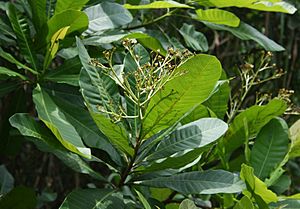Wild cashew facts for kids
Quick facts for kids Wild cashew |
|
|---|---|
 |
|
| Scientific classification | |
| Genus: |
Anacardium
|
| Species: |
excelsum
|
| Synonyms | |
|
Anacardium rhinocarpus (Kunth) de Candolle |
|
The wild cashew (also known as Anacardium excelsum or espavé) is a large tree. It belongs to the same plant family as the regular cashew nut. You can find this tree growing in warm, tropical forests. It grows in Central and South America. It stretches from Guatemala all the way down to Ecuador.
Contents
What Does the Wild Cashew Look Like?
This amazing tree is an evergreen. This means it keeps its leaves all year round. It loves to grow near rivers. The wild cashew can grow very tall, up to 48 m (157 ft). That's like a 15-story building!
Its trunk is straight and has a pretty rose color. It can be as wide as 3 m (9.8 ft) across. The leaves are simple and oval-shaped. They are about 15–30 cm (5.9–11.8 in) long. They are also about 5–12 cm (2.0–4.7 in) wide.
Flowers and Fruit of the Wild Cashew
The flowers of the wild cashew grow in a cluster called a panicle. This cluster can be up to 35 cm (14 in) long. Each flower is small and starts out pale green or white. As the flowers get older, they turn pink. They also start to smell like strong cloves.
The fruit of the wild cashew is a special kind of fruit called a drupe. It is shaped like a kidney bean. Each fruit is about 2–3 cm (0.79–1.18 in) long. The fruits ripen in March, April, and May.
How Wild Cashews Are Related to Other Plants
The wild cashew is very closely related to the common cashew tree. Both trees belong to the same group of plants. Scientists call this group a genus. Their genus is named Anacardium. This means they are like cousins in the plant world.
The Life Cycle of the Wild Cashew
Animals play a big role in the life of the wild cashew. Fruit-eating bats love to pick the fruit from the tree. They carry the fruit to their feeding spots. The bats eat only the soft, fleshy part of the fruit.
After the bats finish eating, they drop the hard nuts. These nuts fall onto the forest floor. They get covered by leaves and other plant bits. Later, these nuts will sprout and grow into new wild cashew trees. This process is called germination.
Uses of the Wild Cashew
The fruit of the wild cashew can be tricky. If you eat it raw, it is very harmful to humans. This includes both the nut and the soft part around it.
However, the fruit can be eaten safely. You just need to roast it first. Cooking the fruit removes the harmful substances.
See also
 In Spanish: Anacardium excelsum para niños
In Spanish: Anacardium excelsum para niños

